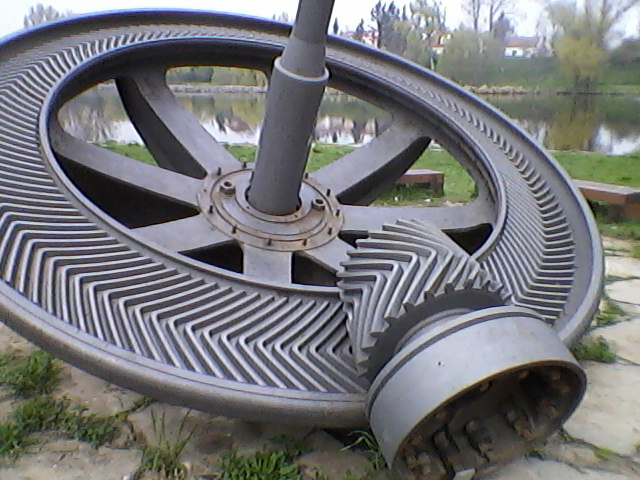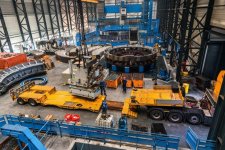Can anybody point me to a good reference (web page, book, catalog, whatever) about the various flavors of gear making technology, why they're used, etc?
Best one : Dudley.
Practical Gear Design (I think. Or words close to that) ... I like the one with the blue cover, it's got less foofoo crap, more manufacturing-oriented. A few chapters on design, a chapter or so on each production method. Not quite as down-and-dirty as you might like but the closest one to that.
Next best : Dudley again,
Gear Handbook. Again, I prefer the older editions, not as much foofoo. But to each their own. This one is more on the design end and a lot of it is really beyond the average user's needs. You're not concerned with hypoids, right ?
On these two books hang all the rules and the prophets ...
If you are looking around the used book stores, one that was put out by Red Ring is interesting as hell.
Modern Methods of Gear Manufacture. They were big on shavers and grinders which you probbaly don't want, the explanations and descriptions in the front are excellent but everybody has a version of those but the great part is - 2/3 of the book is real-life examples. Some really really cool stuff. If you see a copy, grab it just for that.
I'm talking about "skiving" vs "gashing" vs "hobbing" vs "shaping" of gears.
This is easy.
Skiving you will probaly never see. It's like hobbing with negative rake, carbide blanks brazed to the teeth of the hob with funny backwards-angled teeth, used mostly (exclusively ?) for recutting hardened gears. Big gears usually go foofoo in heat treat (small ones too but not as much), skiving is to bring them back to the right size and shape. It's a finishing operation on hard parts. People nowadays go to grinding for that. Grinding is much more accurate and faster.
Gashing is single-tooth cutting. Can be very fast, much faster than any other method, tooth shape is now good but tooth spacing is a problem. Cutters are ungodly expensive. It's economical for big big stuff
or for one-offs. If you wanted to make a replacement part for your 1903 Biggleston shaper, you'd probably gash it using a home-made cutter. Most of the slewing bearings for wind turbines are gashed with $8,000 cutters.
Shaping is usually used for internals, parts with a shoulder or another feature very close (think automotive cluster gears), some really weird shapes (but not sure anyone does that anymore), non-round gears, things that you can't hob for practical reasons. Most people prefer hobbing, shapers reciprocate at high speeds and stuff likes to shake loose. Then kapow ! haul out the checkbook. Also, it's easier to mess up on setup and blow up your $300 cutter. Some things are faster to shape - thin parts like sprockets, especially because there is not as much overtravel. Many people start out with a shaper because the principles are easy to understand and the machine takes up less space and there's a ton of them around for cheap. But you can't cut helicals without a guide for each part, so in general, shaping at the job-shop level is restricted to straight-cut teeth.
Yes, people have tried controlling cutter and part spindles for helicals with cnc, the machines were not super-successful and pretty expensive. Mitsubishi in particular but I don't think anyone uses those in production. I guess they are okay for short-runs and prototypes.
Hobbing - the preferred method for most gear cutting. Threaded cutter moving in synchronization with the blank, bla bla. You can find dozens of good explanations online. If the memory isn't blown out, about 70% of gears are hobbed.
Bevels are in a different family, can't do them with any of the methods above. But there are Spiroids and Planoids and several other weird systems that can be hobbed to cut right-angle gearing. Almost nobody does that tho

Just stick to the normal stuff for now, Kato ....
All of this stuff comes in both mechanical and cnc versions.
If you are thinking of a small repair shop, since I am too old to start anew I'll toss this competitive trade secret out : get a Maag shaper. They are slow as oppossums but they can do just about anything (except for worms) and the cutters are cheap. You can even make your own, easily. Don't know why I didn't do this in the first place ... the lure of high-speed stroking, I guess. Cutters are the bane of a gear shop. No matter how many you have, the damned customers will find a job that needs the one you don't have.
(My google foo for some reason keeps bringing up references to some mech warrior like video game... sigh....)
Ongoing argument with the assistant - "WHY do you insist on looking up technical words on the internet ? you're NOT going to find it !!"
Oh well. What we do for a sniff ....
p.s. If you are thinking about doing this for a shop ? I'd grab someone who had been doing it for a while. There's a lot of stuff you learn the hard way. Having a guy around to help avoid the pitfalls would be worth it, especially in the beginning. Grab some lazy old codger just to tell you "Unh-unh. Cut it tight, that helix is going to unwind in heat treat ..." and that kinda thing. That book-larnin' ain't all there is to the world.


 Just stick to the normal stuff for now, Kato ....
Just stick to the normal stuff for now, Kato .... 





